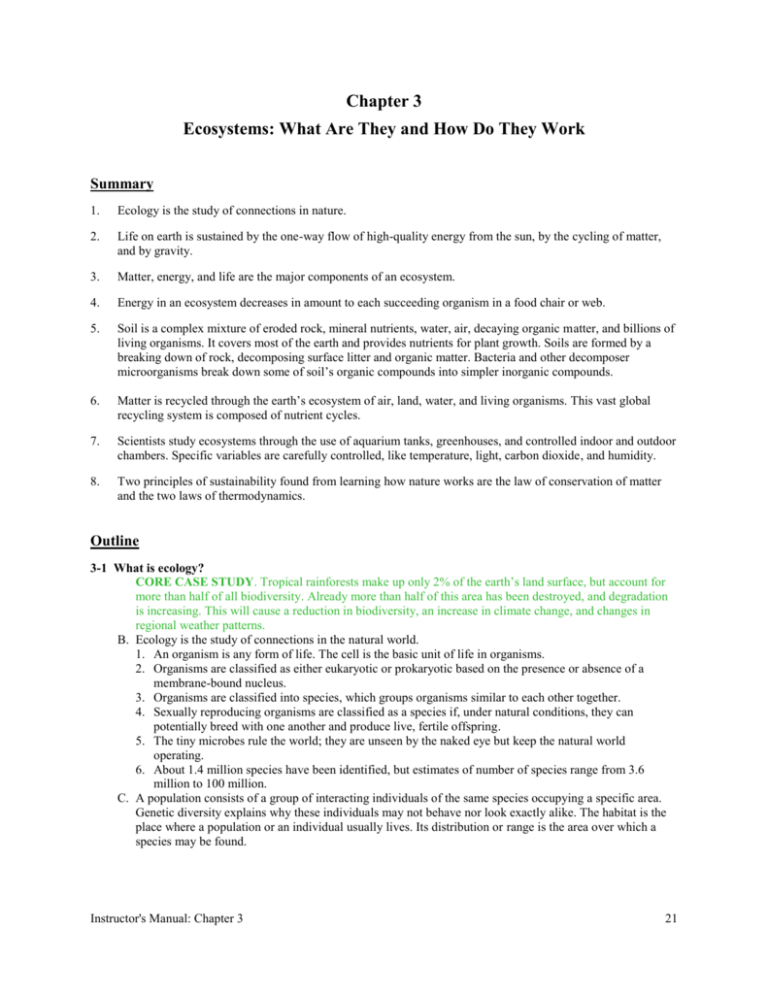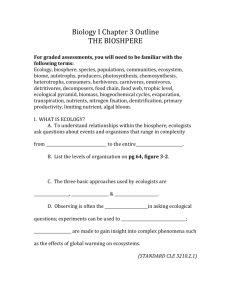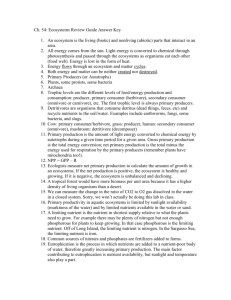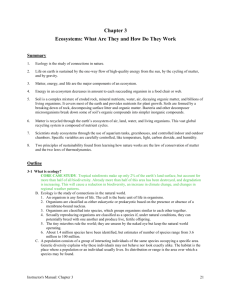Ecosystem study guide ecosystems
advertisement

Chapter 3 Ecosystems: What Are They and How Do They Work Summary 1. Ecology is the study of connections in nature. 2. Life on earth is sustained by the one-way flow of high-quality energy from the sun, by the cycling of matter, and by gravity. 3. Matter, energy, and life are the major components of an ecosystem. 4. Energy in an ecosystem decreases in amount to each succeeding organism in a food chair or web. 5. Soil is a complex mixture of eroded rock, mineral nutrients, water, air, decaying organic matter, and billions of living organisms. It covers most of the earth and provides nutrients for plant growth. Soils are formed by a breaking down of rock, decomposing surface litter and organic matter. Bacteria and other decomposer microorganisms break down some of soil’s organic compounds into simpler inorganic compounds. 6. Matter is recycled through the earth’s ecosystem of air, land, water, and living organisms. This vast global recycling system is composed of nutrient cycles. 7. Scientists study ecosystems through the use of aquarium tanks, greenhouses, and controlled indoor and outdoor chambers. Specific variables are carefully controlled, like temperature, light, carbon dioxide, and humidity. 8. Two principles of sustainability found from learning how nature works are the law of conservation of matter and the two laws of thermodynamics. Outline 3-1 What is ecology? CORE CASE STUDY. Tropical rainforests make up only 2% of the earth’s land surface, but account for more than half of all biodiversity. Already more than half of this area has been destroyed, and degradation is increasing. This will cause a reduction in biodiversity, an increase in climate change, and changes in regional weather patterns. B. Ecology is the study of connections in the natural world. 1. An organism is any form of life. The cell is the basic unit of life in organisms. 2. Organisms are classified as either eukaryotic or prokaryotic based on the presence or absence of a membrane-bound nucleus. 3. Organisms are classified into species, which groups organisms similar to each other together. 4. Sexually reproducing organisms are classified as a species if, under natural conditions, they can potentially breed with one another and produce live, fertile offspring. 5. The tiny microbes rule the world; they are unseen by the naked eye but keep the natural world operating. 6. About 1.4 million species have been identified, but estimates of number of species range from 3.6 million to 100 million. C. A population consists of a group of interacting individuals of the same species occupying a specific area. Genetic diversity explains why these individuals may not behave nor look exactly alike. The habitat is the place where a population or an individual usually lives. Its distribution or range is the area over which a species may be found. Instructor's Manual: Chapter 3 21 D. A community represents populations of different species living and interacting in a specific area. A biological community consists of all the populations of different species interacting and living in a specific area; this is a network of plants, animals, and microorganisms. SCIENCE FOCUS: the importance of insects in maintaining the environmental balance. E. An ecosystem is a community of different species interacting with each other and with their nonliving environment of matter and energy. All of the earth’s diverse ecosystems comprise the biosphere. 3-2 What keeps us and other organisms alive? A. Various interconnected spherical layers make up the earth’s life-support system. 1. The atmosphere is the thin membrane of air around the planet. 2. The troposphere is the air layer about 11 miles above sea level. 3. The stratosphere lies 11–30 miles above the troposphere and filters the sun’s harmful radiation. 4. The hydrosphere consists of earth’s water, found in liquid water, ice, and water vapor. 5. The lithosphere is the crust and upper mantle of the earth. B. The biosphere includes most of the hydrosphere, parts of the lower atmosphere and upper lithosphere. C. Ecology’s goal is to understand the interactions in the earth’s global skin of air, water, soil, and organisms. D. Sun, cycles of matter, and gravity sustain life on earth. 1. The one-way flow of high-quality solar energy through materials and living things (as they eat) produces low-quality energy. Energy can’t be recycled. 2. Matter cycles through parts of the biosphere. 3. Gravity causes the downward movement of chemicals as matter cycles through the earth. E. Solar energy just passes through the earth as electromagnetic waves. F. As solar radiation interacts with the earth, infrared radiation is produced. Greenhouse gases trap the heat and warm the troposphere. This natural greenhouse effect makes the planet warm enough to support life. 3-3 What are the major components of an ecosystem? A. The major components of ecosystems are abiotic (nonliving) water, air, nutrients, solar energy, and biotic (living) plants, animals, and microbes. B. Populations have a range of tolerance to physical and chemical environments. 1. Law of tolerance: The distribution of a species in an ecosystem is determined by the levels of one or more physical or chemical factors being within the range tolerated by that species. a. The limiting factor principle states that too much or too little of any abiotic factor can limit or prevent growth of a population. C. The major biological components of ecosystems are the producers/autotrophs that are self-feeders and the consumers/heterotrophs. 1. Autotrophs make their own food from compounds in the environment. 2. Consumers, or heterotrophs, feed on other organisms or their remains. a. Decomposers break down organic detritus (bacteria/fungi) into simpler inorganic compounds. b. Omnivores feed on both plants and animals. c. Carnivores feed on animals. d. Detritivores feed on dead organic matter and break it down into smaller molecules. e. Herbivores feed on plants. 3. Glucose and other organic compounds are broken down and energy is released by the process of aerobic respiration, the use of oxygen to convert organic matter back to carbon dioxide and water. 4. Some decomposers are able to break down organic compounds without using oxygen. This process is called anaerobic respiration, or fermentation. SCIENCE FOCUS: The importance of microbes to our life. 5. Matter is recycled; there is a one-way flow of energy. 3-4 What happens to energy in an ecosystem? A. Food chains and food webs help us understand how eaters, the eaten, and the decomposed are interconnected in an ecosystem. B. The sequence of organisms as they are eaten is a food chain. 1. Trophic levels are feeding levels for organisms within an ecosystem. a. Producers belong to the first tropic level. b. Primary consumers belong to the second tropic level. 22 Ecosystems: What Are They and How Do They Work? C. D. E. F. G. H. c. Secondary consumers belong to the third tropic level. d. Detritivores and decomposers process detritus from all trophic levels. 2. Food webs are complex networks of interconnected food chains. Energy flow in a food web/chain decreases at each succeeding organism in a chain or web. The dry weight of all organic matter within the organisms of a food chain/web is called biomass. Ecological efficiency is the term that describes the percentage of usable energy transferred as biomass from one trophic level to another and ranges from 2 to 40% with 10% being typical. The greater number of trophic levels in a food chain, the greater loss of usable energy. The pyramid of energy flow visualizes the loss of usable energy through a food chain. The lower levels of the trophic pyramid support more organisms. Production of biomass takes place at different rates among different ecosystems. 1. The rate of an ecosystem’s biomass production is the gross primary productivity (GPP). 2. Some of the biomass must be used for the producers’ own respiration. Net primary productivity (NPP) measures how fast producers can provide biomass needed by consumers in an ecosystem. 3. Ecosystems and life zones differ in their NPP. The planet’s NPP limits the numbers of consumers who can survive on earth. 3-5 What happens to matter in an ecosystem? A. Nutrient cycles/biogeochemical cycles are global recycling systems that interconnect all organisms. 1. These cycles include the carbon, oxygen, nitrogen, phosphorus, and water cycles. B. The water/hydrologic cycle collects, purifies, and distributes the earth’s water in a vast global cycle. 1. Solar energy evaporates water, and the water returns as rain/snow. 2. Some water becomes surface runoff, returning to streams/rivers. 3. Water is the major form of transporting nutrients within and between ecosystems. C. The water cycle is altered by man’s activities. SCIENCE FOCUS: the unique properties of water. 1. We withdraw large quantities of fresh water. 2. We clear vegetation and increase runoff, reduce filtering and increase flooding. 3. We add nutrients like fertilizers and modify the quality of the water. 4. The earth’s water cycle may be speeding up due to a warmer climate. This could change global precipitation patterns and may intensify global warming (water vapor increases in the troposphere). D. The carbon cycle circulates through the biosphere. 1. CO2 gas is an important temperature regulator on earth. 2. Photosynthesis and aerobic respiration circulates carbon in the biosphere. 3. Fossil fuels contain carbon. 4. Carbon recycles through the oceans. Oceans act as a carbon sink, but when warming occurs they release carbon dioxide. 5. Excess carbon dioxide in the atmosphere has contributed to global warming. E. Nitrogen is recycled through the earth’s systems by different types of bacteria. 1. The nitrogen cycle converts nitrogen (N2) into compounds that are useful nutrients for plants and animals. 2. The nitrogen cycle includes these steps: a. Specialized bacteria convert gaseous nitrogen to ammonia in nitrogen fixation. b. Special bacteria convert ammonia in the soil to nitrite ions and nitrate ions; the latter is used by plants as a nutrient. This process is nitrification. c. Decomposer bacteria convert detritus into ammonia and water-soluble salts in ammonification. d. In denitrification, nitrogen leaves the soil. Anaerobic bacteria in soggy soil and bottom sediments of water areas convert NH3 and NH4+ back into nitrite and nitrate ions, then nitrogen gas and nitrous oxide gas are released into the atmosphere. 3. Human activities affect the nitrogen cycle. a. In burning fuel, we add nitric oxide into the atmosphere; it can be converted to NO 2 gas and nitric acid, and it can return to the earth’s surface as acid rain. b. Nitrous oxide that comes from livestock, wastes, and inorganic fertilizers we use on the soil can warm the atmosphere and deplete the ozone layer. c. We destroy forest, grasslands, and wetland and, thus, release large amounts of nitrogen into the atmosphere. d. We pollute aquatic ecosystems with agricultural runoff and human sewage. Instructor's Manual: Chapter 3 23 e. We remove nitrogen from topsoil with our harvesting, irrigating, and land-clearing practices. f. Increased input of nitrogen into air, soil, and water is affecting the biodiversity toward species that can thrive on increased supplies of nitrogen nutrients. F. We need to use phosphorus-based fertilizers because the phosphorus cycle is much slower in moving through the earth’s water, soil, and organisms and is often the limiting factor for plant growth. 1. Phosphorus is used as a fertilizer to encourage plant growth. 2. Phosphorus also limits growth of producers in freshwater streams and lakes due to low solubility in water. G. Man interferes with the phosphorous cycle in harmful ways. 1. We mine phosphate rock to produce fertilizers and detergents. 2. We cut down tropical forests and, thereby, reduce the phosphorus in tropical soils. 3. We compromise aquatic systems with animal waste runoff and human sewage. H. Sulfur cycles through the earth’s air, water, soil, and living organisms. 1. Natural sources of sulfur are hydrogen sulfide, released from volcanoes, swamps, bogs, and tidal flats where anaerobic decomposition occurs. 2. Some marine algae produce dimethyl sulfide (DMS). DMS acts as nuclei for condensation of water found in clouds. This can affect the cloud cover and climate. 3. Sulfur compounds can be converted to sulfuric acid, which falls as acid deposition. 4. Burning coal and oil, refining oil, and the production of some metals from ores all add sulfur to the environment. 3-6 How do ecologists study ecosystems? A. Ecologists do field research, observing and measuring the ecosystem structure and function. B. New technologies such as remote sensing and geographic information systems (GISs) gather data that is fed into computers for analysis and manipulation of data. C. Ecologist use tanks, greenhouses, and controlled indoor and outdoor chambers to study ecosystems (laboratory research). This allows control of light, temperature, CO 2, humidity, and other variables. D. Field and laboratory studies must be coupled together for a more complete picture of an ecosystem. E. Systems analysis develops mathematical and other models that simulate ecosystems that are large and very complex and can’t be adequately studied with field and laboratory research. This allows the analysis of the effectiveness of various alternate solutions to environmental problems and can help anticipate environmental surprises. Key Terms abiotic (p. 57) aerobic respiration (p. 59) anaerobic respiration (p. 59) aquatic life zones (p. 56) atmosphere (p. 54) autotrophs (p. 58) biological community (p. 53) biomass (p. 62) biomes (p. 55) biosphere (p. 53) biotic (p. 57) carbon cycle (p. 67) carnivores (p. 59) chemosynthesis (p. 59) community (p. 53) consumers (p. 59) decomposers (p. 59) detritivores (p. 59) distribution (p. 53) ecological efficiency (p. 62) 24 ecology (p. 52) ecosystem (p. 53) fermentation (p. 59) food chain (p. 61) food web (p. 62) genetic diversity (p. 53) gross primary productivity (GPP) (p. 64) habitat (p. 53) herbivores (p. 59) hydrologic (water) cycles (p. 65) hydrosphere (p. 55) limiting factor (p. 58) limiting factor principle (p. 58) natural greenhouse effect (p. 56) net primary productivity (NPP) (p. 64) nitrogen cycle (p. 68) nutrient (biogeochemical) cycles (p. 65) omnivores (p. 59) Ecosystems: What Are They and How Do They Work? photosynthesis (p. 58) population (p. 52) primary consumers (p. 59) producers (p. 58) pyramid of energy flow (p. 62) range of tolerance (p. 57) secondary consumers (p. 59) species (p. 51) stratosphere (p. 54) sulfur cycle (p. 70) third and higher level consumers (p. 59) trophic level (p. 58) troposphere (p. 54) Additional Video Resources Blue Planet (Video series from Discovery Channel, 2001) Mammoth series, five years in the making, taking a look at the rich tapestry of life in the world's oceans. http://dsc.discovery.com/convergence/blueplanet/blueplanet.html Journey to Planet Earth (Video series from PBS, 2003) http://www.pbs.org/journeytoplanetearth/ The Living Planet — A Portrait of the Earth (hosted by David Attenborough – four discs) This series discusses the biomass and life in a variety of ecosystems spanning many of the environments found on Earth. Planet Earth (BBC Series, 5 discs) An exploration of global ecosystems. http://www.bbc.co.uk/nature/animals/planetearth/ Web Resources Food Chain Curriculum Research Links Interactive exploration of food webs and food chains. http://www.picadome.fcps.net/lab/currl/food_chain/default.htm The Hydrologic Cycle Interactive exploration of various phases of the water cycle. http://polaris.umuc.edu/cvu/envm/hydro/hydro.html Ecosystems: What Are They and How Do They Work? 25









